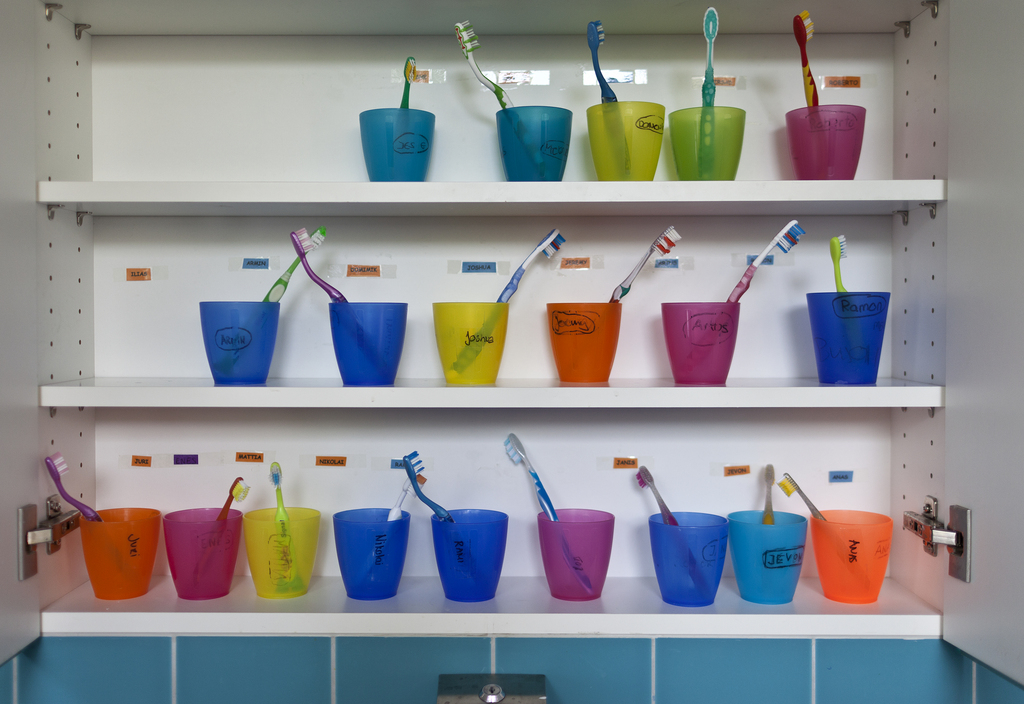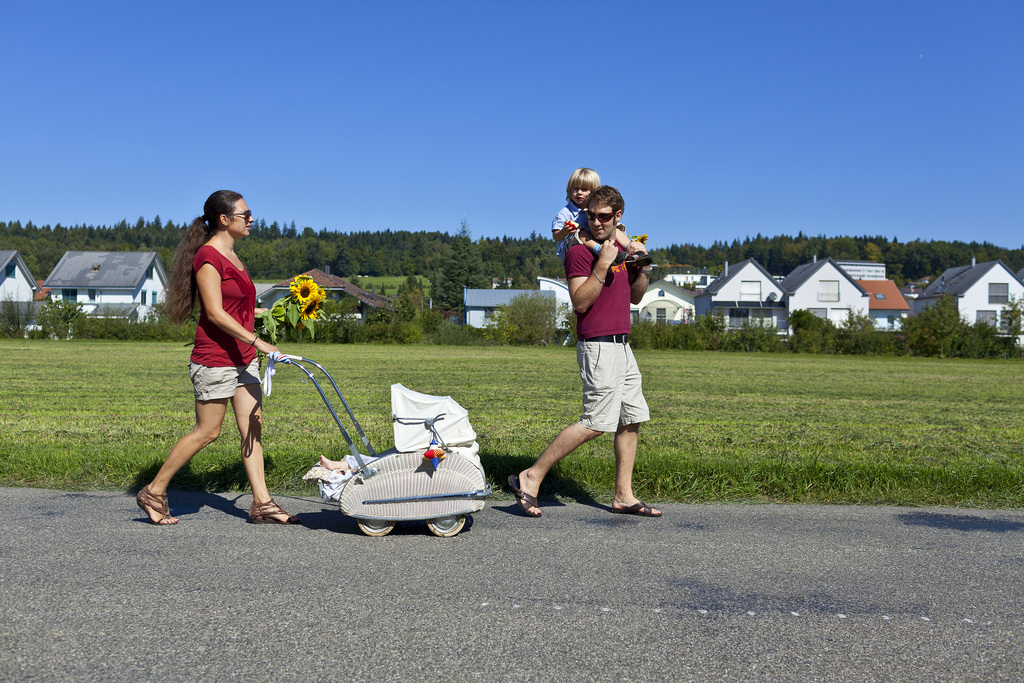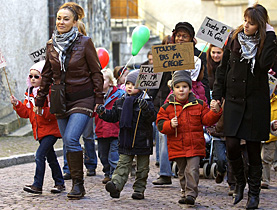Counting the cost of childcare

Childcare is an expensive business in Switzerland. Not only for parents who spend half of their household income on child minding, but particularly also for crèche operators who struggle to chalk up profits.
To stem a shortage of facilities the government in 2003 initiated a CHF440 million ($455 million) incentive programme to fund the creation of crèches. The injection boosted the number of childcare places by more than 15,000 over ten years, adding to the around 50,000 places that already existed.
One crèche owner who benefitted was Darina Hürlimann, who in 2008 founded Kita Matahari, a small day care centre in a wealthy residential area in Bern.
Surrounded by a dozen children – including her own – she shows off the spacious converted two-storey flat with a large eat-in kitchen. State support helped pay off investment debts in the first two years. But she still admits: “Running this crèche is a non-profit operation.”
It’s also about multitasking. She spends about 70 per cent of her time on administrative duties, including salary statements, letters to parents and meal plans.
“I need to stay on top of everything all the time and never stand still. I’m constantly juggling my own values, plans and finances,” Hürlimann says, as children cling to her legs or bustle about the bright rooms filled with modern furniture.
“Places have to be filled within three months for me to reach an optimal occupancy rate, and so far I’ve always managed. Success means not losing money.”
There are more than 2,000 crèches in Switzerland, according to the Swiss Crèche Association (KiTaS). About 90% are private. They are primarily financed by parents’ contributions. The government contributes through subsidies to the centre, the parents or through childcare ‘vouchers’ issued by the government.
A spot check by the Swiss price watchdog in 2011 showed that fees of public institutions vary wildly across the country, between CHF40 per day in Bellinzona in the south and CHF130 in the central town of Schwyz.
Private crèches cost between CHF60 and CHF150 per day in the cities of Bern and Zurich. A subsidised place costs about CHF10, the crèche association estimates.
The cost of looking after one child costs crèche operators up to CHF170 per day, according to a survey by the Swiss price watchdog. The facility needs an occupancy rate of at least 80 per cent, it has to be affordable and have a central location to stay in business.
To set up a business, managers have to invest as much as CHF4,000 per place, the association estimates. Salaries make up for 80 per cent of these costs, operations and rent the rest. The monthly rental costs vary between CHF1,000 to CHF7,000.
High cost
Thanks to such new centres it is generally easy to find a place in a larger city, even at short notice, said Talin Stoffel, head of the Swiss Crèche Association KiTaS. The problem is the cost for parents.
As parents have to foot about 80 per cent of the bill, one full-time place in a city costs them up to CHF2,500 a month, or close to CHF40,000 a year.
“The operating costs of running a crèche are comparable with other countries, but the parents’ share is much higher,” Stoffel explained. “One child is just about financeable, but the second doubles the costs, pushing many families to their limits. That’s why most people can only afford day care part-time.”
“In Switzerland the view is still engrained that childcare before kindergarten is up to the family, that the state shouldn’t interfere with private affairs and that only poor people who rely on a second salary should be supported to put kids in a crèche,” Stoffel added.
This was also illustrated by the fact that Swiss voters in March rejected a proposal to promote the creation of child day care facilities. It failed to win a majority among the mostly rural 26 cantons and was opposed by the right who argued it added an additional financial burden for taxpayers and was an interference by the state in family matters.
She points to a study by economist Monika Bütler from the University of St Gallen, which showed that for many families a double income is not an asset but a liability. The salary of a mother working three days a week is swallowed by childcare costs and additional taxes, she calculated, and in some cases, extra pay will even reduce household income.
According to the 2011 OECD report Doing Better for Families, families in Switzerland spend half of their income on childcare – more than in any other country in the world. Their share is almost double that of second-placed Britain and more than four times the OECD average of 12 per cent.
“This is far too much,” said Miriam Wetter, who heads the Swiss childcare network. “The costs affect the decision whether women can afford childcare outside the family and whether they end up having children at all.”
Finding a crèche place may still be difficult in rural areas and for babies, but availability has improved in recent years, particularly in urban areas. There are more vacancies in August, when the older children start kindergarten. There are usually long waiting lists for subsidised places.
The cantons Vaud and Fribourg have a system where the employers contribute to a fund, which then partially finances the crèches.
Other parts of the country rely on private initiatives by parents, institutions or companies. The Swiss system works if the municipalities are backing the crèches.
The child care network brings together childcare institutions, companies, researchers and government bodies to improve the quality of services offered.
Some municipalities support childcare facilities because they want to attract foreign workers to the area. Universities and larger companies such as the Swiss Post, ABB, Credit Suisse or Roche, and institutions such as universities, hospitals or local governments offer their staff individual solutions. The Federal Institute for Technology in Zurich has struggled to hire people from abroad because it could not guarantee crèche places.
Alternatives to crèches are nannies and au-pairs, which are more flexible and around if the child is sick. For a couple of hours, parents may also leave a child at a playgroup or a babysitter, but they are not licensed to look after larger numbers of kids and for longer periods of time.
More subsidies are needed, experts say
Parents are already paying over the odds and crèches can’t afford to drop the costs, said Wetter, a political scientist who also presides the board of a crèche. “We can only assure quality at lower prices with a higher volume of subsidies.”
When the government pledged its support with the 2003 funding programme, many people versed in child minding took the opportunity to set up a crèche, Stoffel said, recalling the gold-rush mood.
“They were really good at their jobs, but after opening, they soon realised that they ended up not having much time for the children because of all the administrative duties,” Stoffel explained.
And the main challenges for crèche managers still are a lack of qualified personnel and demanding financial aspects, she said.
Many who have got into financial difficulties simply manage to survive because of the demand for places, Wetter said. There are a lot of smaller operations with very localised small-scale solutions to the crèche shortage.
A crèche is a small to medium-sized company. Running it not only requires the obvious educational skills and child-minding concepts, but also concepts for operations, hygiene and safety, according to a 300-page handbook published by the crèche association. Managers need to develop a business plan and a budget, and look at quality management, pricing and marketing, Wetter said.
In future there may be a shift towards larger bodies with a centralised back office working for several crèches, a structure the leolea day care organisation has slowly grown into since 2003, offering individually managed childcare facilities for crèches in Bern and Lucerne.
A centralised administration allows the crèche managers to better concentrate on childcare.
But even leolea is a non-profit association, said executive secretary Nathalie Klemm.“Even with centralised cost structures childcare facilities can’t be run in a profit-oriented manner.”
Childcare historically is now part of social welfare, while after school care centres for kids from around the age of four belong to the education system, says historian Talin Stoffel, who heads KiTaS.
In 2003 the government pledged CHF440 million to support the creation of additional facilities to allow parents to strike a better balance between family and working life.
The crèche association published a 300-page handbook, which gives an overview over guidelines, rules and regulations, which are different in every region and municipality.
The authorities regulate the ratio of minders per child or the requirements for staff training, and also the facility’s technical requirements including the municipal building inspection’s regulations on zone assignment, hygiene and fire codes.

In compliance with the JTI standards
More: SWI swissinfo.ch certified by the Journalism Trust Initiative


You can find an overview of ongoing debates with our journalists here . Please join us!
If you want to start a conversation about a topic raised in this article or want to report factual errors, email us at english@swissinfo.ch.